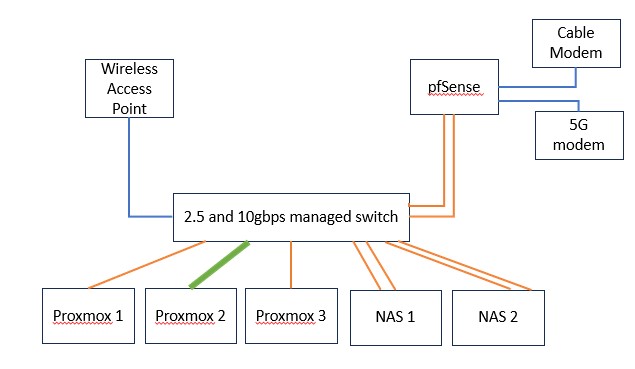@Louie1961 Hi Louie! Thank you for your informative reply. I will take everything you have written in to consideration. Please don’t take my reply as trying to debate you, I’m just argumenting for the sake of learning.
emphasized text
I’ll take a shot here, after examining your chart in detail. First I think you have too many switches. You could probably eliminate all but one or two of the switches and accomplish the same thing with VLANs.
*I have three switches in my network. *
*UniFi Enterprise 8 PoE Switch: I suggest this switch because I would appreciate the 10 GbE capacity for my NAS-to-Home-Office configuration. At the same time I would appreciate the 2.5 GbE capacity that is available with the UniFi U7 access point. The “Enterprise 8 PoE” was the only switch that could provide these features in a single unit. Please correct me if I’m wrong. *
UniFi Flex XG: I suggest this switch because I need a 10 GbE switch in my Home Office to send/recieve from the NAS. I’m aware that my printer does not need 10 GbE but I didn’t find any less expensive UniFi switch that provides 10 GbE connectivity. I’m all open for other suggestions. *
UniFi Flex Mini: I’m aware I could run my Entertainment Center devices on WiFi but I would appreciate the stability and capacity that wired connections provide, especiallty for my TV and Gaming console. That’s why I chose this simple 1 GbE switch.
Second, the way you diagrammed the Synology is not correct in my opinion. You don’t dedicate drive bays to specific tasks. Drive bays are used for creating various forms of RAID and then you dedicate storage pools on that RAID array to various tasks.
Ok! I’m not sure I understand this at all. I will look more into this. Thanks!
Third, it seems a waste to run 10 gbe networking to a printer.
I agree! The 10 GbE is for the laptop and the printer gets to be on the same switch because they are in the same location.
Fourth, I am not sure I would run wired connections to the televsion, and other home entertainment stuff.
Please see above reply.
In my home network I have a 24 port 2.5gbe/6 port sfp+ switch. Just one switch. I have a wireless access point that is VLAN aware, and I have 5 different VLANs set up: Trusted, Untrusted, Guest, IOT, Television, and Server mgmt. Trusted is for my and my wife’s PCs only, Untrusted is stuff I have facing the internet via cloudflare tunnels (think wordpress and nextcloud), Guest if for guests and my kids, IOT is all the Ring and home assistant stuff, Televisions are for the home entertainment, and Server Mgmt is for the management consoles of my proxmox hosts, my switch and my WAP.
The WAP can have up to 8 SSIDs, each on a different VLAN, Each VLAN has its own IP range and DHCP server in pfSense. Also in pfSense, I have firewall rules that make it so traffic cannot cross VLAN borders. Each VLAN can go out to the internet, but not to other VLANs, except for my trusted VLAN, it can “see” into any VLAN, but not the other way around. With 24 ports of 2.5gbe I have dual links (LACP) between my switch and the pfsense box, and my switch and my NAS boxes, and a 10gbe link to my main Proxmox box (which is really useless, but I wanted to try it)
If I were you I would consider doing more with VLANs and put things like the entertainment stuff and your printer on wireless. Like you really don’t need a 10gbe switch for your office, you could go directly from your main switch to your laptop, and just put the printer on wireless. Same for all your entertainment stuff, you could eliminate that switch as well.
Here is my network diagram with redundant internet connectivity, one switch and one WAP supporting 5 different VLANs. Orange links are 2.5gbe, green is 10gbe and blue is 1gbe (just because the connection on the WAP is 1 gbe)
Thanks for all your advice! I will definitely look more into all of it and take it in consideration. I will definitely run separate VLANS, similar to your setup, but these are layed out in another diagram. I might start with just purchasing the firewall, the main switch, the cloudkey and the AP and run everything on Wifi. Then if I feel the need for wired connectivity, I could buy the other switches.

